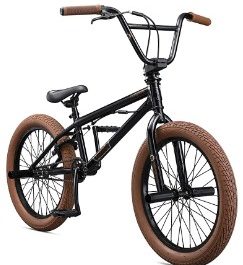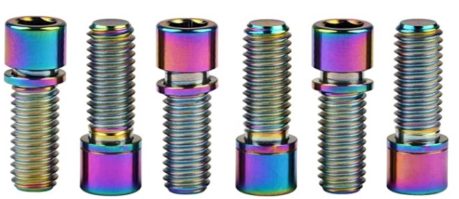To be clear, it’s not every day that you go out looking for stem bolts for your BMX bike. However, since nothing lasts forever, you should be interested in knowing what to get when that time comes. So, are BMX stem bolts universal, or they’re varied?
Collectively, BMX stem bolts are universal as their sizes range around 5-8 millimeters. Technically, however, BMX bike stem bolts come in different sizes – M8, M6, or M5 – where M refers to the metric designation, while the number after it stands for the bolt’s diameter in millimeters.
So, the word universal only applies to BMX stem bolts as a collective unit. But to be specific, you cannot call them universal but varied.
Let’s dive further to explain this argument.
Why Are BMX Stem Bolts Universal?
As mentioned above, BMX bikes usually have stem bolts 5mm, 6mm, or 8mm in diameter. The bolts have threads that come with varying thread pitches.
A thread pitch is a distance between threads in millimeters. For M5 bolts, the standard thread pitch is 0.8. For M6, it’s 1.0, and for M8, it’s 1.25.
Thread callouts are used to identify different screw and bolt types. A thread callout indicates details about the bolt such as diameter, length, thread pitch, etcetera.
If you buy from a physical shop, the callouts are usually printed on a label on the package. For online shopping, the product description usually indicates the relevant bolt details.
For instance, a stem bolt advertised as 8 x 1.25mm means that the diameter is eight millimeters with a thread pitch of 1.25 millimeters. A bolt advertised as M5 x 16mm means the diameter is five millimeters with a thread length of sixteen millimeters.
There are different callout systems with their equivalent reading charts. The bolts come in varying lengths and a standard thickness of either 20mm or 25mm.
With the technical details covered, follow along as we talk about other pertinent details about stem bolts that you need to know.
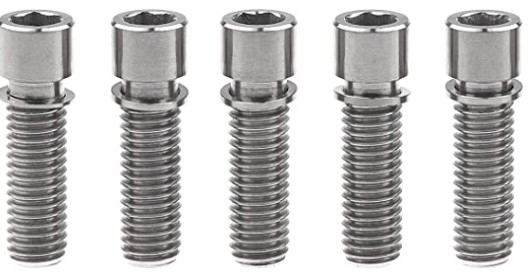
Stem and Stem Bolts – What Are They?
The stem is what connects the forks and the handlebars. They come as either threadless or a quill system and are held in place using stem bolts.
A stem bolt is a mechanical fastener that holds the handlebars in place. It keeps the stem securely in place, stopping it from self-adjusting while riding.
2-Bolt System vs 4-Bolt System
The stem bolts go into the faceplate at the top or sides. The faceplates have different designs and are named depending on the number of bolts needed to hold them in place.
For most BMX bikes, the design is either a 2-bolt or 4-bolt system. Bikes that have quill system stems generally have the 1-bolt design. Some riders have also personalized their faceplate design to have no-bolt designs.
While the 1-bolt system looks neat, it has one major flaw – it has a single point of failure. On the other hand, the no-bolt system will involve welding services in case of damage.
Some riders claim that there isn’t much difference between the feel and function of the two types of designs. Below is a discussion of the two-stem bolt systems to help you decide which one to choose.
a) 2-Bolt System
The faceplate is held in place using two bolts.
2-Bolt System Pros
- The bolt sizes are larger compared with the ones in a 4-bolt system
- The bolts are easier to torque
2-Bolt System Cons
- The rider’s safety is significantly compromised if one bolt breaks down as the handlebars completely detach
b) 4-Bolt System
The faceplate is held in place using four bolts. They’re the most common, especially for BMX and mountain bikes.
4-Bolt System Pros
- This type of design clamps over a large area and is, as a result, more stable.
- Since there are more bolts, this design allows for the usage of smaller-sized bolts. For mountain bikes that use this type of design, the screws can be as small as 3 millimeters.
- The increased number of bolts helps in case one breaks down. The handlebars will still be firmly in place.
4-Bolt System Cons
- They are more expensive than the 2-bolt systems as they use more bolts
- This system has more weight due to the wide faceplate and increased number of bolts
- The smaller screws used by this design strip break easily
Best Material for BMX Stem Bolts
Stem bolts come from the following different materials.
Stainless Steel
This material offers high-strength bolts and is inexpensive. Some manufacturers electro-polishes their bolts to make them more corrosion resistant.
If you’re into stainless steel, get yourself the Ritchey WCS 4Axis (Check on Amazon) replacement stem bolts that will offer you excellent service at a reasonable price.
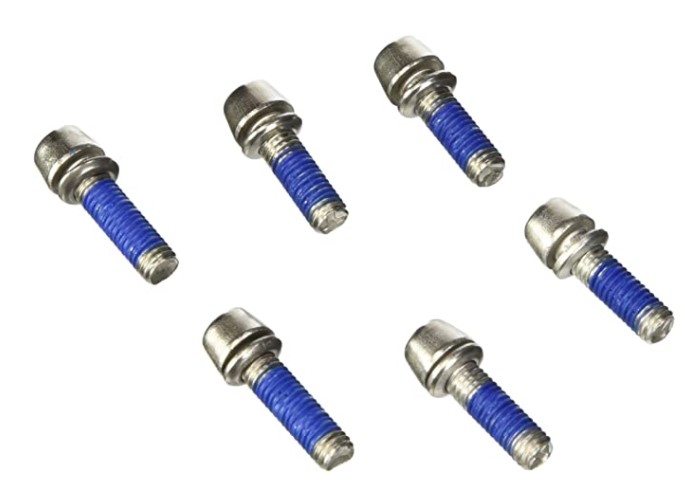
Titanium
High-quality titanium makes strong stem bolts with very high tensile strength. However, you will have to confirm that the stem bolts are certified as high-quality titanium.
Running low-quality and cheap titanium stem bolts known to snap can cause injury.
If you’re an ardent titanium fan, the Wanyifa Titanium (Check on Amazon) stem bolt is what you’re looking for. It’s made from Grade 5 titanium which is as strong as steel and yet 45% lighter.
Other materials used to manufacture BMX bike stem bolts that are not so common include copper and aluminum alloy. Some stem bolts, such as Wanyifa, have PVD gold coating color for that unique look.
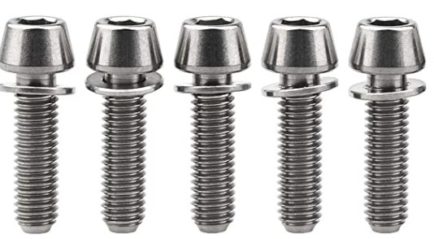
How to Measure BMX Stem Bolts?
It’s important to note that even with an experienced eye, sometimes, just eyeballing the stem bolts might not accurately measure them. So, how does one take the measurements for the correct size of bolts?
You can use a digital caliper, a bolt gauge, or a necklace gauge to get accurate stem bolt measurements. The bolt gauge is the more robust measurement tool.
You can measure the stem bolt’s diameter, thickness, thread pitch, and length with the same instrument.
The bolt necklace is a trial and error method where you pick your bolt and screw it into all the available gauges until you find a fit. Some details about the bolt are on the side of the gauge.
How to Replace BMX Stem Bolts for a Threadless Stem?
If your stem bolts are top-placed, straddle your bike over the top tube to help in maintaining stability. If they’re at the front, straddle over the front wheel.
Using the appropriate hex wrench, loosen the stem bolts. The number of bolts to remove depends on the type of system used for the faceplate. If you find it difficult to remove the bolts due to rust, use a rust remover such as this fast-acting WD-40 Penetrant (View on Amazon).
If the difficulty is due to other reasons such as destroyed bolt heads, use a Torx wrench such as this Titan 12715 as it has more grip. The Torx wrench will also work when tightening the bolts to the correct torque.
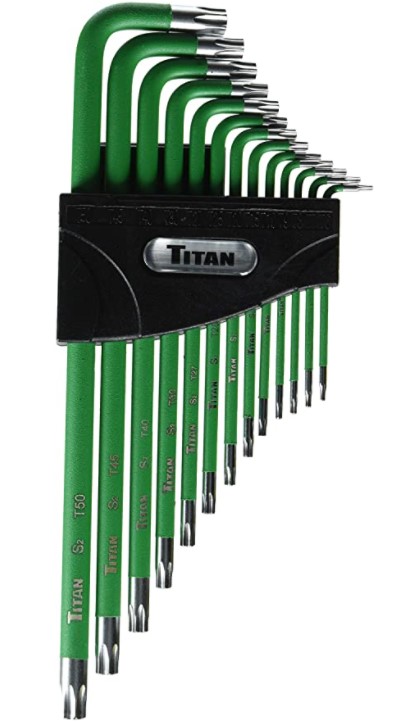
How to Maintain BMX Stem Bolts?
If you get rid of maintenance, whole systems break down. That is true for your bike and stem bolts in particular. Here’s how to give your stem bolts more service life.
- Rust can be a major problem for stem bolts. Your first defense point is your stem bolt choice to rid yourself of the rust menace.
- Titanium and stainless steel stem bolts offer the best protection against rust. The next option is to regularly apply lube like WD-40 Penetrant (mentioned earlier) to all the rust-prone areas.
- Another issue is that the stem bolts can snap if overtightened. For that reason, always make sure to torque your bolts to the correct levels. Ensure you get the correct stem bolt measurements to prevent the threads from stripping.
People Also Ask
What Size Are BMX Stem Bolts?
BMX stem bolts generally come as five, six, or eight millimeters. They’re technically designated as M5, M6, and M8 and come with different thicknesses and lengths. The letter M is the metric designation, and the number that follows is the diameter in millimeters.
How Tight Should BMX Stem Bolts Be?
How tight the stem bolts should be is dependent on the manufacturer’s instructions. Generally, though, the range is between 4-6 N/M torque.
Overtightening the stem bolts creates pressure points and can cause damage to the tightening tool. If applied for long, the pressure points will damage the handlebar tube. The bolt head can break off, and the threads stripped.
Overtightened bolts are also tough to remove. The situation can worsen if the bolts get rusty.
Under-tightening the stem bolts is also not advised. Loosely tightened bolts will cause slippage between the items fastened together, damaging the bolts.
In Conclusion – Are BMX Stem Bolts Universal?
BMX stem bolts come in varying sizes and shapes. The standard size for BMX stem bolts is usually 5mm, 6mm, or 8mm in diameter with varying lengths, thread pitch, and thickness. There are exceptions to this, however.
Some BMX bikes, specifically those using the 2-piece faceplate system, have stem bolts 7mm in diameter. So, before buying a new set of stem bolts, invest in a bolt gauge, calipers, or necklace gauge to get accurate stem bolt measurements.
Or better yet, take one piece from your stem and head into your local bike shop for the replacement.
Relevant Post:
